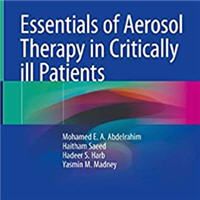Tag: ARDS
Outcome After Intubation for Septic Shock with Respiratory Distress and Hemodynamic Compromise
Intubation within 24 h of sepsis was not associated with hospital mortality but resulted in fewer 28-day hospital-free days. Although intubation remains a high-risk procedure, we did not identify an increased risk in mortality... read more
The Effect of Lowering Tidal Volume on Mortality
The use of low tidal volume (4-8 ml/kg of predicted body weight) has been considered the default way to ventilate patients with acute respiratory distress syndrome (ARDS) to minimize ventilator-induced lung injury (VILI).... read more
miR-221-5p-Mediated Downregulation of JNK2 Aggravates ALI
Sepsis and acute lung injury (ALI) are linked to mitochondrial dysfunction; however, the underlying mechanism remains elusive. We previously reported that c-Jun N-terminal protein kinase 2 (JNK2) promotes stress-induced mitophagy... read more
Metabolomic Diferences: COVID-19 vs. H1N1 Influenza in ARDS
This study aimed to compare the specificity of the metabolic alterations induced by COVID-19 or Influenza A pneumonia (IAP) in acute respiratory distress syndrome (ARDS). Our findings support the concept that ARDS is associated... read more
Safety and Efficacy of MUST-ARDS
This important first study, using multipotent adult progenitor cells in ARDS patients (MUST-ARDS), was a phase 1/2 randomised, blinded, placebo-controlled trial that demonstrated safety and tolerability of intravenous administration... read more
COVID-19 Infection Triggers Profibrotic Macrophage Responses and Lung Fibrosis
COVID-19-induced acute respiratory distress syndrome (ARDS) is associated with prolonged respiratory failure and high mortality, but the mechanistic basis of lung injury remains incompletely understood. Here, we analyzed... read more
Essentials of Aerosol Therapy in Critically Ill Patients
This book assesses the most appropriate forms of aerosol therapy for critically ill patients. Aerosol therapy is applied for the treatment of several pulmonary diseases in addition to some promising applications intended... read more

ARDS vs. PseudoARDS – Failure of the Berlin Definition
True ARDS might be defined as a histological diagnosis involving diffuse alveolar damage throughout the lungs (characterized by hyaline membrane formation and thickening of the alveolar walls). PseudoARDS refers to patients... read more
Brain–lung Interactions and Mechanical Ventilation in Patients with Isolated Brain Injury
During the last decade, experimental and clinical studies have demonstrated that isolated acute brain injury (ABI) may cause severe dysfunction of peripheral extracranial organs and systems. Of all potential target organs... read more
Longitudinal Respiratory Subphenotypes in COVID-19 Patients with ARDS
COVID-19-related ARDS has no consistent respiratory subphenotype. Patients diverged from a fairly homogenous to a more heterogeneous population, with trajectories of ventilatory ratio and mechanical power being the most discriminatory.... read more
Continuous Positive Airway Pressure and Pronation Outside the ICUs in COVID-19 ARDS
Continuous positive airway pressure with patient mobilization (including pronation) was effective and safe in patients with ARDS due to COVID-19 managed outside the intensive care unit setting during the pandemic. Of 90... read more
Higher vs. Lower PEEP in ARDS Patients
In our meta-analysis of RCTs, higher positive end-expiratory pressure (PEEP), compared with lower PEEP, was not associated with mortality in patients without acute respiratory distress syndrome (ARDS) receiving invasive mechanical... read more
Precision Medicine and Heterogeneity of Treatment Effect in Therapies for ARDS
Acute respiratory distress syndrome (ARDS) is a clinically heterogenous syndrome, rather than a distinct disease. This heterogeneity at least partially explains the difficulty in studying treatments for these patients... read more
Fungal Infections Complicating COVID-19
Coronavirus disease 2019 (COVID-19), caused by the severe acute respiratory syndrome coronavirus 2 (SARS-CoV-2), spread globally to pandemic proportions. Although the majority of cases have asymptomatic or mild infections,... read more

Intubation Timing As Determinant Of Outcome in Patients with ARDS By COVID-19 Infection
In COVID-19 patients, late intubation, Pafi ... read more
Personalized Mechanical Ventilation in ARDS
A personalized mechanical ventilation approach for patients with adult respiratory distress syndrome (ARDS) based on lung physiology and morphology, ARDS etiology, lung imaging, and biological phenotypes may improve ventilation... read more
When Could Airway Plateau Pressure is Acceptable in ARDS Patients?
Limitation of plateau pressure (Pplateau) is critical for pro-tection from ventilator-induced lung injury in patients with acute respiratory distress syndrome (ARDS). Limiting to a 30 cmH2O threshold is a widely accepted... read more
Prone Positioning and Survival in Mechanically Ventilated Patients with COVID-19
In-hospital mortality was lower in mechanically ventilated hypoxemic patients with coronavirus disease 2019 treated with early proning compared with patients whose treatment did not include early proning. Among 2,338 eligible... read more
Aerosolised Surfactant Trial for Preterm Infants with RDS
The AeroFact system can safely deliver aerosolised surfactant to preterm infants with respiratory distress syndrome (RDS) who are on nasal continuous positive airway pressure (nCPAP). 10 infants were enrolled in part 1... read more
Delirium and long term cognition in critically ill patients
Delirium, a form of acute brain dysfunction, is very common in the critically ill adult patient population. Although its pathophysiology is poorly understood, multiple factors associated with delirium have been identified,... read more
Protecting The Injured RV in COVID-19 ARDS
The abnormal interaction between the right ventricle (RV) and pulmonary vasculature in various disease states is associated with adverse clinical outcomes. Impaired RV physiology in acute respiratory distress syndrome (ARDS)... read more
Non-invasive Respiratory Support and P-SILI in COVID-19
Coronavirus disease 2019 (COVID-19) pneumonia is associated with hypoxemic respiratory failure, ranging from mild to severe. Due to the worldwide shortage of intensive care unit beds, a relatively high number of patients... read more









